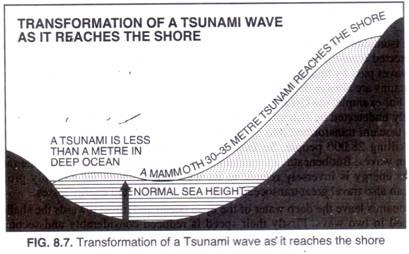Here is your paragraph on tsunamis !
Tsunamis consist of a series of very long waves which travel outwards on the surface of the ocean in all directions away from their place of origin.
Their movement is just like ripples created by throwing a pebble into a pond of water.
In deep sea the tsunamis travel at very very high speed (say 500-800 km per hour), almost as much as the speed of a jet aircraft. Their wavelength is very long which often exceeds 500-700 km. However, the amplitude of tsunamis in deep sea-is very low and rarely exceeds 1 metre. Physically they propagate as long waves with speed given by
ADVERTISEMENTS:
(Water depth x gravitation acceleration)1/2
Since the tsunamis have very long wavelength and very low amplitude, in deep ocean, they cannot be seen or detected from the air. Therefore, passengers on boats cannot feel or see the tsunami waves as the killer waves pass by underneath at high speeds.
ADVERTISEMENTS:
It may only appear as a gentle rise and fall of the sea. Thus tsunamis are always deceptive and are able to conceal their killing capacity in the deep water of open area. For example, the Great Sanriku tsunami, which struck Honshu in Japan on June 15,1896 was completely undetected by fishermen as its deep water height was only about 40 cm.
A monster in disguise, this tsunami transformed into huge waves when it arrived on the shore and ravaged 275 km of coastline killing 28,000 people. So from the sky tsunami waves cannot be distinguished from ordinary ocean waves.
But beneath, a tremendous amount of energy lurks. Since the rate at which the wave loses its energy is inversely related to its wavelength, tsunamis not only propagate at high speeds, they can also travel great transoceanic distances with limited energy losses.
As the tsunamis leave the deep water of the open ocean and travel towards the shallow water, they are transformed in two ways. Firstly their speed is reduced considerably and secondly they attain emormous height often exceeding 10 metres and occasionally may reach 30 metres. Figure 8.6 shows the origin of tsunamis and their propagation from deep water of open sea to the coast.
Since the speed of the tsunami is related to the water depth (see expression above), it diminishes in shallow water. Frictional force of the sea bed also plays its part in reducing the speed of the tsunami. Thus the initial speed of 500-700 km per hour is reduced to 50-60 km per hour near the coast.
When the tsunami finally reaches the shore it may appear as a series of breaking waves. The successive waves stack up onto each other forming a pile of waves due to which the tsunami waves get compressed near the coast.
ADVERTISEMENTS:
Consequently, the wavelength of the tsunami waves is shortened and the wave energy is directed upwards. This makes the wave grow in height. Since the total energy of the waves remains constant (Law of Conservation of Energy), the height of these waves increases dangerously.
This is also known as ‘shoaling’ effect because it transforms a seemingly harmless wave that was almost imperceptible in deep water into an incredibly dangerous wall of water on the shore. So if the amplitude of the ‘tsunami’ wave have been just one metre or even less in the deep water, it grows into a mammoth 30-35 m wave when it sweeps over the shore (Fig. 8.7). That is why tsunami waves smash into the shore with devastating impact of a water bomb.
The maximum height reached by a tsunami on the shore is called the run up. This is the vertical distance between the mean sea level surface and the maximum height reached by the tsunami waves on the shore. Generally the tsunami run-up over a metre is considered dangerous. After run up, a part of tsunami energy is dissipated back to open ocean.
ADVERTISEMENTS:
This generates particular type of waves called ‘edge waves’ that travel back-and-forth parallel to the shore. Sometimes tsunami causes the water to recede, exposing the ocean floor.
Tsunamis undergo a lot of refraction on reaching the shore. Refraction of tsunamis depends upon water depth and configuration of the sea floor near the shore. The process of refraction converges a part of energy of the tsunami waves to particular areas on the shore. So on reaching the shore, the presence of coral reefs (fringing or barrier reefs), bays, slope of the beach and other undersea features may modify the tsunamis.
Effects of Tsunamis:
Tsunami poses serious danger to the inhabitants of the coastal areas. They attack the sea shore as gigantic waves, moving with great force, appearing without a warning and hitting the coastline like a water bomb. Loaded with enormous energy, the killer waves wreck havoc by flooding hundreds of metres inland, past the typical high water level.
They flatten houses and wipe out villages, uproot electric poles, throw cars into swirling waters and toss boats ashore all in mad fury, and finally drag thousands of hapless victims out to sea as they recede. Large rocks weighing several hundred tonnes and other debris can be moved hundreds of metres inland by a tsunami. Tsunamis can even travel up rivers and streams that lead to the ocean.
